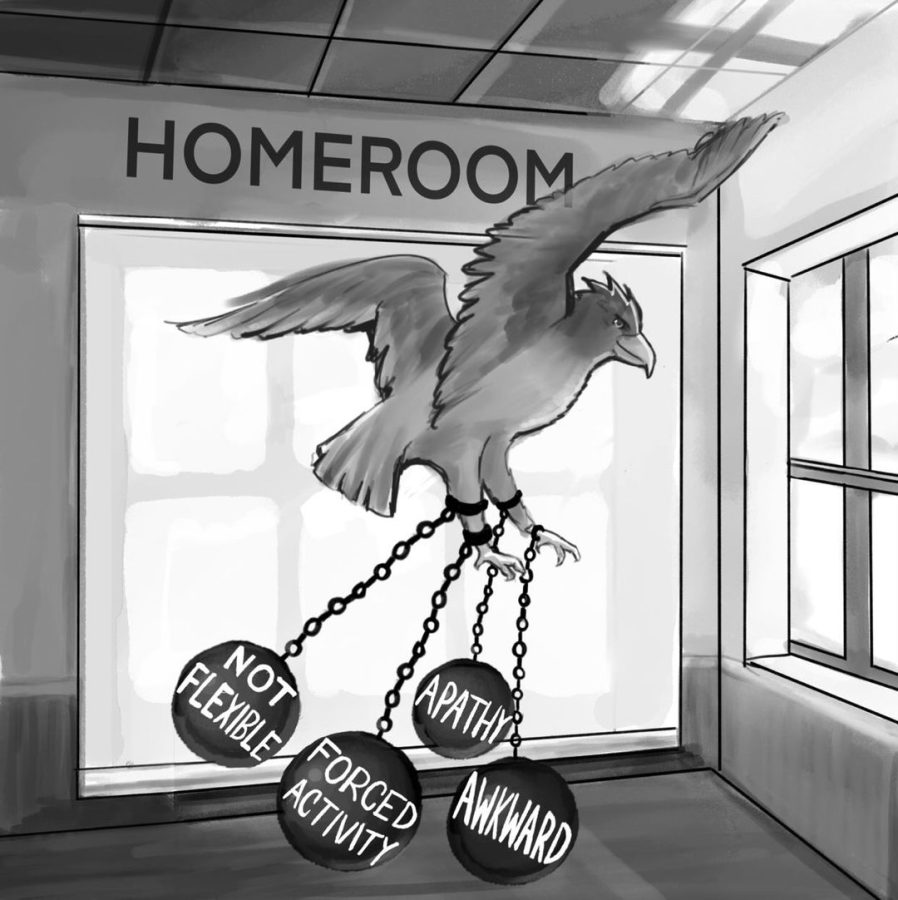Editorial: SOAR Homeroom: Too much of a (potentially good) thing
September 24, 2022
Apathetic teachers, standardized presentations and awkward interactions. That’s what students say their homeroom periods are like. By most accounts, homeroom has been largely ineffective at achieving its intended purpose: building community.
In each homeroom period, students grouped together by alphabetical order are assigned to two teachers who often don’t know each other. Teachers follow a standardized slide deck with mandatory items such as HawkTV, fire drills and surveys, followed by suggested activities that range from coloring to icebreakers.
Homeroom is a great time to run through these mandatory items because they don’t eat up class time. But the community-building activities are forced and unengaging, especially when homeroom only happens two times a month now. For many students, homeroom isn’t seen as a “real” period; they goof off and catch up with their friends and play technology hide-and-seek with teachers. Community-building cannot be built in such an inauthentic way.
Instead, it is the opinion of this editorial board that the solution lies in giving students and teachers more agency in their homerooms. Students should be given unstructured time after mandatory items and choose how they spend it within the classroom: study hall, catching up with friends they don’t normally see, or even organizing class activities themselves. Teachers can interact with students without the burden of an artificial icebreaker. The homerooms that have created the most natural, enjoyable communities also have teachers who deliberately deviate from the slide decks.
In the past, District 204 high schools have implemented an “Advisory” period every Wednesday where students are free to choose how they spend that time within the building: there are nap and meditation rooms, academic support, study halls and places for students to lay low. This unstructured time has no signup; it is a free-flowing system that emphasizes student well-being. While an “Advisory” period every Wednesday may not fit Central’s homeroom-support system, these principles of flexibility and mental health can. Students’ needs often evolve minute by minute, and sometimes, deciding two to three days ahead of time what we’ll need is not realistic.
Another core issue is that teachers and students have no choice in who they’re with. Staff and students with no previous connection are shoved in the same room and expected to bond. Just as they need the freedom to choose how to develop relationships, students need the freedom to choose who to spend their time with.
Homeroom doesn’t need to be an arbitrary alphabetical split — it could be interest based. Debate could get a homeroom. The bike club could get a homeroom. The football team could get a homeroom (or several, if they didn’t fit in just one). By doing so, students would have a reason to bond with each other and build real communities.
School spirit has been an ongoing issue and we’re thankful that our school administration has taken note and intends for SOAR to help with community-building. But, the over-standardization and lack of staff-and-student agency are mitigating its potential benefits. If these issues of inflexibility and inauthenticity can be solved, students could look forward to a more engaged and stronger school community.
Students should be given the opportunity to demonstrate they can do what’s best for them. An unstructured time might prove to be less of a logistical nightmare while also helping the well-being of students. Considering how busy many students are, couldn’t a bit of downtime go a long way?








